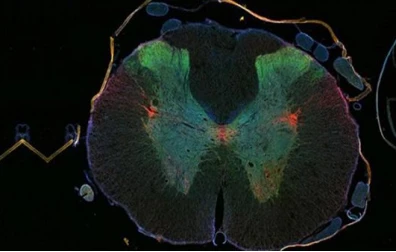Studies have found that PARP inhibitors can alleviate amyotrophic lateral sclerosis

Studies have found that PARP inhibitors can alleviate amyotrophic lateral sclerosis

Copyright © iCell Bioscience Inc, Shanghai 2018-2019
A PARP inhibitor is a cancer therapy that targets poly ADP ribose polymerase. It is the first anticancer drug that has been successfully approved for clinical use using the Synthetic Lethality concept.
PARP is another important DNA repair protein in the cell outside the BRCA protein. The former mainly repairs DNA single-strand damage, and the latter mainly repairs DNA double-strand damage. Tumor cells in cancer patients carrying BRCA1 or BRCA2 germline mutations are inactivated due to BRCA protein, and DNA damage repair becomes very dependent on PARP. If PARP activity is further inhibited, these cells will produce a large amount of DNA damage during division. Cancer cells die.
Dr. Nancy Bonini, a professor at the University of Pennsylvania, and his colleague Dr. James Shorter led a study that found that in addition to preventing tumor cells from repairing damaged DNA, PARP inhibitors can also reduce amyotrophic lateral sclerosis (ALS). It is known as the formation of Lou Gehrig's disease-related structures, as well as some forms of frontotemporal degeneration (FTD).

TDP-43 is a member of the heteronuclear nuclear ribonucleoprotein (hnRNP) protein family, affecting pre-mRNA splicing, transcription, mRNA stability and mRNA transport. In ALS and FTD, hyperphosphorylated TDP-43 protein molecules are in the cytoplasm and can co-locate with parts of the "stress granule". However, the specific mechanism of TDP-43 pathological aggregation into the nucleus remains unknown.
Scientists have found that in Drosophila, a PARP called tankyrase is down-regulated, which reduces the accumulation of TDP-43 in the cytoplasm and effectively reduces neurodegeneration. It was further determined that TDP-43 binds PAR non-covalently by intercalating the PAR binding sequence region within its nuclear localization sequence.
Experiments have shown that PAR binding promotes liquid phase separation of TDP-43 and demonstrates in mammalian cell and neuronal cell assays that this binding is a prerequisite for the accumulation of TDP-43 in stress granules. Targeting stress particles initially protects TDP-43 from disease-associated phosphorylation, but in long-term stress, stress particles dissociate, leaving phosphorylated TDP-43 aggregates.
Further experiments in cultured mammalian cells demonstrated that the PARP inhibitor, a small molecule of Tankyrase-1/2, inhibited the formation of only TDP-43 hyperphosphorylated aggregates in the cytoplasm without affecting the assembly of stress particles. Tankyrase inhibitors antagonize the pathological progression and neurodegeneration associated with TDP-43 and may therefore have therapeutic utility for ALS and FTD.
Researchers believe that PARP inhibitors are easily used for brain disease after fine-tuning. Given the lack of treatment (for ALS and FTD), the results of these experiments are excited, and these experiments help to elucidate the molecular mechanisms of the disease and may lead to the discovery of new therapies.
Although no one has tested PARP inhibitors in neurodegenerative diseases, this class of drugs is generating interest in potential uses in areas other than breast cancer and ovarian cancer.
 Loading ....
Loading ....
